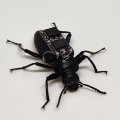Poorest people are partners in battle against chicken disease
Professor Peter Spradbrow, from the University of Queensland, is racing against retirement to complete a lifetime's work devoted to science and the welfare of mankind.
Professor Spradbrow works with a small team in the relative isolation of the University's Veterinary Science Farm, at Pinjarra Hills, outside Brisbane.
However, from there his work touches the lives of countless thousands of people throughout Africa and Asia whose wellbeing depends so much on the humble village chicken.
A virologist specialising in poultry, the focus of his research has been Newcastle disease, a highly contagious virus which attacks chickens, crippling their respiratory systems and killing virtually every infected bird.
Professor Spradbrow has spearheaded research enabling heat-resistant vaccines to be produced in remote rural centres through a simple process of cultivating the virus inside locally-laid fertile eggs.
Through workshops and demonstrations, local technicians have learnt how to grow the virus while farmers are being taught to administer it and how later to test chickens for disease resistance.
'At present we see no sustainable way to vaccinate village chickens except by producing vaccine locally and having the vaccine applied by farmers,' Professor Spradbrow said.
'Quite often flocks of scavenging chickens are all poor people have. They are kept for food, for cultural, social and perhaps medicinal purposes, as a source of savings and especially for barter.
'For poor rural families, they are often the only resources that are available for disposal when seed rice or school books must be purchased, or when poll taxes become due.'
The rapid breeding cycle of chickens also made them a quickly renewable resource. This could be vitally important in war-ravaged countries where stocks of larger animals had been decimated and took long generations to replace.
Official estimates put the number of chickens in Africa at around 1.6 billion with millions more in Asia. Saving them from disease makes a huge difference to the nutrition and income of countless poor families.
Professor Spradbrow's work on Newcastle disease dates back more than 20 years and since 1984 has benefited from around $1.5 million worth of funding from the Australian Centre for International Agricultural Research.
While some peripheral research has been conducted in other countries, the University is firmly at the forefront of this project. 'Not much happens without us at least being consulted,' Professor Spradbrow said.
He has made as many as 60 trips abroad, often spending two or three months away a year talking to people and teaching the new techniques. His efforts have assisted in the fight against Newcastle disease in places like Malawi, Zambia, Botswana, Zimbabwe, Tanzania, Senegal, Ethiopia, the Philippines, Vietnam, Malaysia, Thailand, Indonesia and Sri Lanka
Professor Spradbrow said there had long been vaccines for commercial flocks of chickens. However, these were heat sensitive and only available in large doses of perhaps 1000 shots which was wasteful and expensive for family-owned flocks of maybe 10 to 25 birds.
His work at the University first led to the development of a vaccine which did not need refrigeration, making it ideal for use in isolated rural communities. Next came research into the best and most practical means of administering the vaccine and ways of making it in small doses.
However, the main thrust of Professor Spradbrow's work has been in teaching people in developing countries how to make their own vaccine in small, relatively simple rural laboratories. The basic elements needed are an incubator, a candling lamp and a syringe.
The vaccine is cultured by injecting a dose into fertile eggs from local chickens. The eggs are held up to the lamp, showing the embryo inside and the area where vaccine can be injected through the shell.
Professor Spradbrow said a 20-egg incubator should produce at least 50,000 doses of vaccine every fortnight. These would need to be distributed within a few weeks or, if stored in a fridge, could keep for months.
A key role is played in the field by research assistant Sally Grimes who demonstrates how to inoculate and harvest the eggs and later bleed chickens to test immunity levels by measuring the presence of virus antibodies.
Research has found the most efficient and effective method of administering the vaccine is through eye drops though in cases where the chickens are roaming semi-wild and cannot be caught, doses can be added to food or water.
Professor Spradbrow said eye-droppers were not always available in remote areas. He recounted a case in Tanzania where local ingenuity was employed to deliver a drop of vaccine into the bird's eye using the tip of a chicken feather.
His overseas experience has underlined the importance of working with local people and teaching them to help themselves rather than becoming just passive recipients of western technology.
Professor Spradbrow has plenty of goals he would still like to achieve before he retires in two years time, including setting up a Web site for village chicken disease and husbandry studies.
In one of the very poor areas, such as Ghana where he has just spent three weeks, he would also like to help establish a working model of the Newcastle disease prevention program which other similar places could copy.
For further information, contact Professor Peter Spradbrow (telephone 3365 5735)
.jpg)


